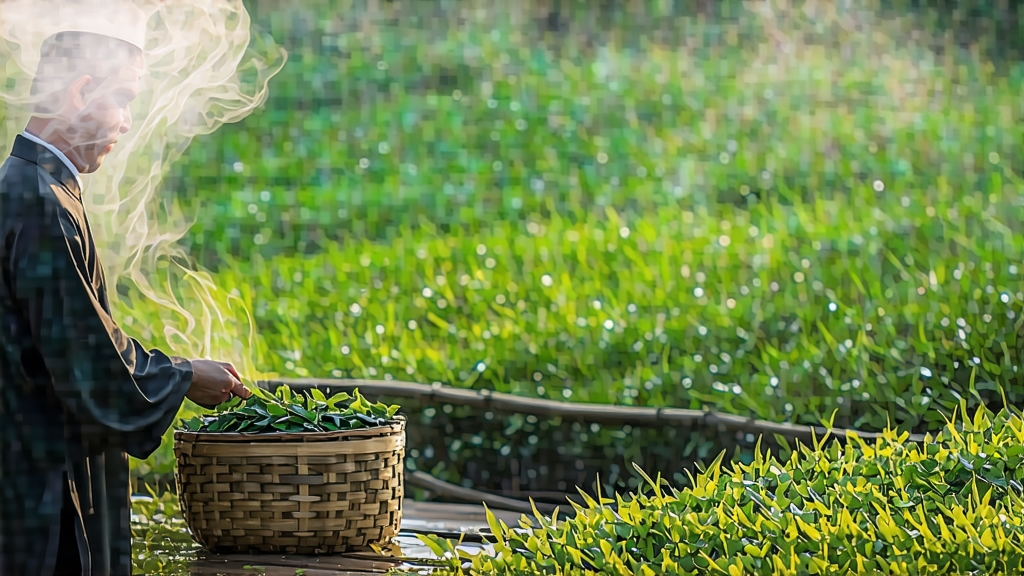
Longjing, literally “Dragon-Well,” is the most celebrated name among China’s more than one thousand green-tea varieties. To the Chinese palate it is the liquid equivalent of jade—cool, luminous, and quietly luxurious. To the outside world it remains mysterious, often imitated yet rarely understood. This essay invites the global tea lover to step inside the small, fog-veiled hills west of Hangzhou, where the real Longjing begins, and to follow the leaf from Tang-dynasty legend to twenty-first-century teapot.
-
Historical echoes
The first written record dates to 760 CE, when the Buddhist monk Lu Yu, author of the Classic of Tea, noted that the water of Hangzhou’s Dragon-Well spring was “sweet enough to reveal the soul of tea.” By the Song dynasty (960-1279) the imperial court had placed the area under official supervision; during the Qing, the Qianlong Emperor personally picked bushes on Lion Peak and conferred them royal status. When Queen Elizabeth II visited Hangzhou in 1986, she was served Longjing in a porcelain gaiwan; the photograph flashed across wire services and turned the tea into a diplomatic calling card. Today the Chinese government still gifts 200 grams of pre-Qingming Longjing to each foreign state banquet, a reminder that this leaf has long doubled as soft power. -
Micro-terroirs within West Lake
Only leaves grown inside the 168 km² UNESCO-protected West Lake Scenic Area may legally bear the name West Lake Longjing. Within that radius four micro-zones command cult followings:- Lion Peak (Shi Feng): granite soil, highest diurnal range, produces the most amino acids, giving a chestnut-sweet umami.
- Dragon-Well Village (Longjing Cun): the original well still bubbles behind a stone arch; tea grown here carries a faint bamboo aroma from surrounding groves.
- Clouds Nest (Yunqi): higher humidity, slightly broader leaf, a creamier texture.
- Tiger-Run (Hupao): iron-rich spring water irrigates the terraces, yielding a brisk, iron-mineral finish.
Beyond these hills similar cultivars are grown in Zhejiang’s Qiantang, Yuezhou and Xinchang counties; they are labeled Zhejiang Longjing, perfectly pleasant yet lacking the floral complexity that mist, quartz soil and centuries-old clonal selection confer on the West Lake original.
-
Cultivars: seeds of identity
The heirloom species is Qunti, a seed-propagated landrace with small, thick leaves that tolerate high heat during pan-firing. In 1979 agronomists released Longjing #43, a clonal selection that sprouts five to seven days earlier, yields higher, and presents a more uniform emerald appearance. Purists revere Qunti for its lingering after-sweetness; entrepreneurs favor #43 for its photogenic looks and earlier market entry. A third cultivar, Zhongcha 102, is gaining ground for frost resistance, yet connoisseurs detect a faint grassy note absent in the other two. When buying, check the plucking code printed on Chinese packaging: QT for Qunti, LJ43 for Longjing #43. -
The alchemy of pan-firing
Unlike Japanese greens that are steamed, Longjing is shaped and dried in a bare wok heated to 280 °C within minutes of picking. A master—always addressed as shifu—uses only the radial side of his palm to press, tumble, and coax the leaf into the famous flat sword shape. Ten minutes of high heat “kills the green” (sha qing), locking in chlorophyll and stopping oxidation; the temperature is then dropped to 80 °C for a further twenty minutes of “hui chao,” during which moisture drops to 6 % and amino acids caramelize into nutty notes. One shifu handles only 250 g per batch; a top-grade kilo therefore demands four hours of non-stop wrist work. Machines now mimic the motion, but the best lots are still finished by hand because only human skin can detect the exact second when the leaf turns from supple to brittle. -
Seasonal clock: before the spring rain
Chinese tea time is counted in solar terms. The most coveted leaves are picked before Qingming, the day around 4 April when ancestral graves are swept. Pre-Qingming Longjing enjoys forty slow-growth days, accumulating theanine under